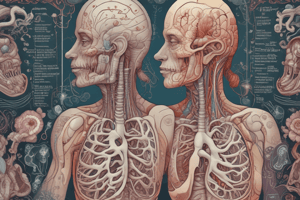Podcast
Questions and Answers
Which of the following organs are part of the respiratory system? (Select all that apply)
Which of the following organs are part of the respiratory system? (Select all that apply)
What is the function of external respiration?
What is the function of external respiration?
Movement of gas between the air in the atmosphere and in the lungs and blood.
What is the pH range that blood should be maintained at?
What is the pH range that blood should be maintained at?
7.35-7.45
The nasal septum divides the nasal cavity into top and bottom parts.
The nasal septum divides the nasal cavity into top and bottom parts.
Signup and view all the answers
The _______ is the visible structure that forms a prominent feature of the face.
The _______ is the visible structure that forms a prominent feature of the face.
Signup and view all the answers
Match the following parts of the nasal cavity to their descriptions:
Match the following parts of the nasal cavity to their descriptions:
Signup and view all the answers
Study Notes
Respiratory System Anatomy
- Organs: The respiratory system is composed of the external nose, nasal cavity, pharynx (throat), larynx (voice box), trachea (windpipe), bronchi, and lungs.
- Ventilation: The movement of air in and out of the lungs, also known as breathing.
-
Respiration: Exchange of gases across a cell membrane.
- External respiration: Exchange of gases between the air in the lungs and the blood.
- Internal respiration: Exchange of gases between the blood and the body cells.
Respiratory System Divisions
-
Anatomical:
- Upper respiratory tract: nose, pharynx, and larynx.
- Lower respiratory tract: trachea, bronchi, bronchiole tree, and lungs.
-
Physiological:
- Conducting zone: Nose to the smallest air tubes, responsible for ventilation and air passage.
- Respiratory zone: Alveoli within the lungs, where gas exchange occurs between carbon dioxide and oxygen.
Respiratory System Functions
- Gas exchange: Primary function of the respiratory system, involving the exchange of oxygen and carbon dioxide.
- Regulation of blood pH: Changes in blood carbon dioxide levels can alter blood pH, which in turn influences breathing rate.
- Production of chemical mediators: The respiratory system produces angiotensin-converting enzyme, a key player in blood pressure regulation.
- Voice production: Air flowing past the vocal chords creates sound and speech.
- Olfaction: The specialized sense of smell occurs in the olfactory epithelium located at the root of the nasal cavity.
- Protection: The respiratory system's protective mechanisms include mucus and cilia, as well as epithelium that defends against harmful pathogens.
The Nose
- The external nose is the visible structure of the nose, forming a prominent facial feature.
-
Composition:
- The upper part, or bridge of the nose, contains the nasal bone.
- The lower part is softer and composed of hyaline cartilage.
- The nostrils, or nares, are the external openings of the nose.
Parts of the Nasal Cavity
-
The nasal cavity is the space inside the nares, extending from the nares to the choanae.
-
Key Components:
- Choanae: Posterior openings of the nasal cavity, connecting to the pharynx.
- Vestibule: The area inside the nostrils, where air initially enters.
- Nasal septum: Partition dividing the nasal cavity into left and right sides.
- Hard palate: Floor of the nasal cavity, located anteriorly. It's composed of the maxilla and palatine bone, separating the nasal cavity from the oral cavity.
- Conchae: Three shell-like structures (superior, middle, and inferior) that play a role in cleansing and humidifying inhaled air.
- Meatus: Spaces between the conchae (superior, middle, and inferior).
- Nasolacrimal duct: Conducts tears from the eyes to the nasal cavity.
-
Epithelial linings:
- The interior of the nostrils is lined with stratified squamous epithelium containing course hairs, filtering dust particles.
- The rest of the nasal cavity is lined with pseudostratified columnar epithelial cells, contributing to mucus production and trapping inhaled particles.
Studying That Suits You
Use AI to generate personalized quizzes and flashcards to suit your learning preferences.
Related Documents
Description
Explore the intricate anatomy and physiology of the respiratory system. This quiz covers the organs involved, the divisions of the respiratory tract, and the processes of ventilation and respiration. Test your knowledge on how the respiratory system operates and its significance in gas exchange.



